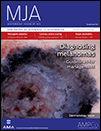The prevalence of monogenic diabetes in Australia: the Fremantle Diabetes Study Phase II
Abstract
Objective: To determine the prevalence of monogenic diabetes in an Australian community.
Design: Longitudinal observational study of a cohort recruited between 2008 and 2011.
Setting: Urban population of 157 000 people (Fremantle, Western Australia).
Participants: 1668 (of 4639 people with diabetes) who consented to participation (36.0% participation).
Main outcome measures: Prevalence of maturity-onset diabetes of the young (MODY) and permanent neonatal diabetes in patients under 35 years of age, from European and non-European ethnic backgrounds, who were at risk of MODY according to United Kingdom risk prediction models, and who were then genotyped for relevant mutations.
Results: Twelve of 148 young participants with European ethnic backgrounds (8%) were identified by the risk prediction model as likely to have MODY; four had a glucokinase gene mutation. Thirteen of 45 with non-European ethnic backgrounds (28%) were identified as likely to have MODY, but none had a relevant mutation (DNA unavailable for one patient). Two patients with European ethnic backgrounds (one likely to have MODY) had neonatal diabetes. The estimated MODY prevalence among participants with diagnosed diabetes was 0.24% (95% confidence interval [CI], 0.08–0.66%), an overall population prevalence of 89 cases per million; the prevalence of permanent neonatal diabetes was 0.12% (95% CI, 0.02–0.48%) and the population prevalence 45 cases per million.
Conclusions: One in 280 Australians diagnosed with diabetes have a monogenic form; most are of European ethnicity. Diagnosing MODY and neonatal diabetes is important because their management (including family screening) and prognosis can differ significantly from those for types 1 and 2 diabetes.




